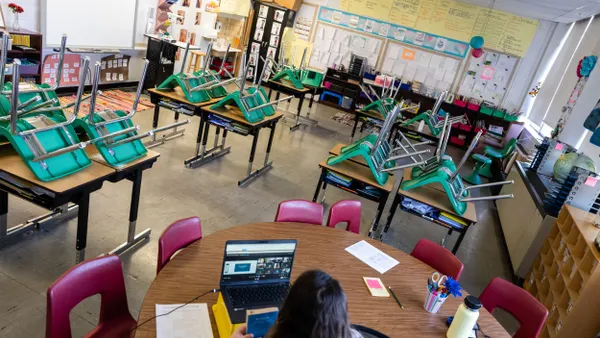Dive Brief:
- Updated guidance from the U.S. Department of Education for state and district spending of $189.5 billion in federal COVID-19 emergency funding provides more details on allowances and restrictions for outlays, but doesn't give any more information on extensions for investment of the final two aid allocations.
- The FAQ document updated Wednesday, for example, provides more information on how Elementary and Secondary School Emergency Relief funding can be used for certain construction projects, including when natural disasters damage buildings or equipment. However, the document warns some projects may exceed spending timelines.
- As the education system hits the halfway mark of the ESSER lifecycle, education leaders are being urged to assess their spending practices to date and make decisions about the use of remaining funds.
Dive Insight:
Pressure continues to build regarding the urgent but thoughtful budgeting process for ESSER money, however, the FAQ could help education leaders who are uncertain if their plans meet federal requirements for spending.
The document also illustrates how unique the situation is in that schools have an influx of flexible money yet so many priority areas in need and a limited time to make investments.
In a new section of the FAQ, for example, the Education Department describes how ESSER and Governor's Emergency Education Relief funds can be spent on family engagement activities and assessments for multilingual learners.
Another section explains how the use of ESSER funds for purchasing and installing video security systems would be allowable in limited circumstances as it relates to promoting safe and secure schools.
The updated FAQ explains how ESSER funds cannot be used to renovate or construct athletic facilities, such as playing fields and swimming pools, unless there is a connection between the expenditure and the district's COVID-19 response.
"In addition, the Department discourages LEAs [local education agencies] from using these funds for new construction, as this use of funds limits an LEA’s ability to meet other, more pressing needs related to the pandemic’s impact on learning and the emotional and mental health and well-being of our children and youth," the FAQ said.
Last month AASA, The School Superintendents Association, and EducationCounsel hosted a webinar that recommended districts analyze their spending progress to date, make adjustments to capitalize on areas of strength, and develop strategies for sustained programing after ESSER funds run out.
The webinar included information on a guide developed by Education Resource Strategies on how districts can use data to set goals for the remainder of ESSER funds they have. ERS is a nonprofit that works with school systems on allocation of resources.
"Our motto has been from the start that districts who will be most successful with ESSER are the ones that have improved the most over time, not the ones that had the best plan from the start and so, [we] really wanted to place an emphasis on this halftime moment to step back and reflect and adjust," said Emily Parfit, director at ERS, during the webinar.







 Dive Awards
Dive Awards





